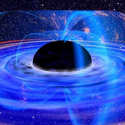An event on the horizon
A black hole engulfs all matter and light within its event horizon and, if anything, should get more massive with time. But in 1975 Stephen Hawking famously predicted that quantum fluctuations at the event horizon of a black hole would slowly, on the time scale of the universe, cause it to evaporate [1]. Unfortunately, the cosmic microwave background would swamp the predicted radiation from all but the most minute black holes (the temperature of the radiation varies inversely with the mass of the black hole).
Suppose we could search for Hawking radiation in a system that was mathematically similar to a black hole? William Unruh proposed looking for such “analogue Hawking radiation” at the boundary separating sound waves moving in one direction at supersonic speeds, from those moving the other direction at subsonic speeds, which would correspond to the event horizon of a black hole [2]. Following this idea, several experiments have been proposed to explore analogue Hawking radiation in Bose-Einstein condensates and optical media.
Writing in Physical Review Letters, Paul Nation, Miles Blencowe, and Alexander Rimberg at Dartmouth College in the US and Eyal Buks at Technion in Haifa, Israel, propose that a magnetic field-pulsed microwave transmission line made up of an array of superconducting quantum interference devices, or SQUIDs, reproduces physics analogous to that of a radiating black hole. The properties of these devices are very well understood and the authors believe that, in principle, they could be tuned to a regime beyond that considered by Hawking—namely, the regime analogous to that requiring a quantum mechanical description of gravity.
Nation et al. acknowledge that, as with previous proposals, the measurements would be difficult. Still, as Unruh commented in his original paper, they may be simpler than “creating a black hole”. – Jessica Thomas
[1] S. W. Hawking, Nature 248, 30 (1974).
[2] W. G. Unruh, Phys. Rev. Lett. 46, 1351 (1981).





